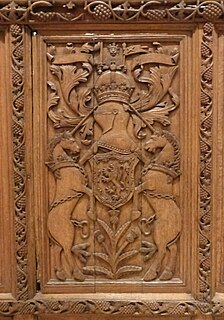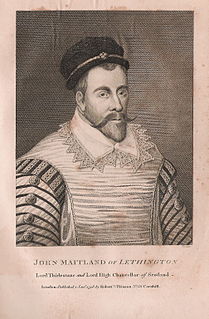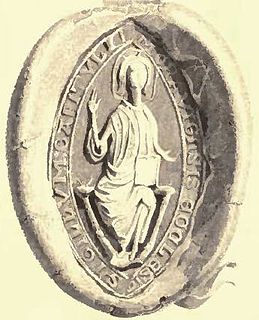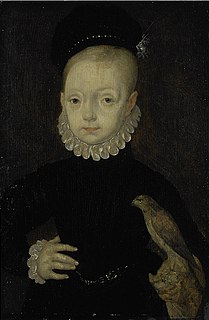Related Research Articles

James III was King of Scots from 1460 until his death in battle in 1488. James was an unpopular and ineffective monarch owing to an unwillingness to administer justice fairly, a policy of pursuing alliance with the Kingdom of England, and a disastrous relationship with nearly all his extended family. It was through his marriage to Margaret of Denmark that the Orkney and Shetland islands were added to the territorial possessions of the Scottish crown.
William Sinclair (1410–1480), 1st Earl of Caithness (1455–1476), last Earl (Jarl) of Orkney, 2nd Lord Sinclair and 11th Baron of Roslin was a Norwegian and Scottish nobleman and the builder of Rosslyn Chapel, in Midlothian.

The office of Keeper of the Privy Seal of Scotland, one of the Great Officers of State, first appears in the reign of David II. After the Act of Union 1707 its holder was normally a peer, like the Keeper of the Great Seal. The office has remained unfilled since the death of Gavin, Marquess of Breadalbane in 1922.

Harald Maddadsson was Earl of Orkney and Mormaer of Caithness from 1139 until 1206. He was the son of Matad, Mormaer of Atholl, and Margaret, daughter of Earl Haakon Paulsson of Orkney. Of mixed Norse and Gaelic blood, and a descendant of Scots kings, he was a significant figure in northern Scotland, and played a prominent part in Scottish politics of the twelfth century. The Orkneyinga Saga names him one of the three most powerful Earls of Orkney along with Sigurd Eysteinsson and Thorfinn Sigurdsson.

Spynie Palace, also known as Spynie Castle, was the fortified seat of the Bishops of Moray for about 500 years in Spynie, Moray, Scotland. The founding of the palace dates back to the late 12th century. It is situated about 500 m from the location of the first officially settled Cathedral Church of the Diocese of Moray, Holy Trinity Church in present-day Spynie Churchyard. For most of its occupied history, the castle was not described as a palace — this term first appeared in the Registry of Moray in a writ of 1524.
John Cameron was a 15th-century Scottish cleric, bishop of Glasgow, and Keeper of the Privy Seal.

Sir John Skene, Lord Curriehill (1549–1617) was a Scottish prosecutor, ambassador, and judge. He was involved in the negotiations for the marriage of James VI and Anne of Denmark.

John Maitland, 1st Lord Maitland of Thirlestane, of Lethington, Knight (1581), was Lord Chancellor of Scotland.

Clan Spens or Spence is a Lowland Scottish clan and is also a sept of Clan MacDuff.
John de Ralston was a 15th-century Scottish bishop and administrator. He was regarded as illegitimate, although today his parents are not known. Ralston appears in the records for the first time in 1426, where he is chaplain and secretary to Archibald Douglas, 5th Earl of Douglas. He retained this position on the death of Douglas in 1439. Between 1429 and 1443 he served as the fourth provost of Bothwell Collegiate Church, the home church of the Douglas earls. On 26 November 1445 he became dean of the diocese of Dunkeld.

Andrew Stewart was a 15th-century Scottish prelate and administrator.
The Archdeacon of Shetland was the head of the Archdeaconry of Shetland, a sub-division of the Diocese of Orkney in Scotland This archdeacon was one of the two archdeacons of the diocese, the other being the Archdeacon of Orkney. Next to the bishop, the Archdeacon of Shetland was the senior ecclesiastic in the diocese.
William Stephen, sometimes William Stephani, was a medieval prelate based in Scotland, who became Bishop of Orkney and then Bishop of Dunblane. A reader in divinity at the University of St Andrews at its first establishment, he was provided by Avignon Pope Benedict XIII as Bishop of Orkney 15 November 1415. He was a canon of Moray at this date. The consecration took place at the Papal court.
Lady Margaret Erskine was a mistress of King James V of Scotland and mother of Regent Moray.
Sir Patrick Vans of Barnbarroch, or Patrick Vaus, was a Scottish judge and diplomat.
Thomas Vaus [de Vaus, Vause] was a 15th-century Scottish royal official and cleric. He was a graduate of the University of Paris, being admitted there as a Bachelor ad eundem in 1445, graduating as a Licentiate in 1447. At some stage he completed an M.A., and bore the title of "Master". His brother Martin Vaus, later Dean of Ross, was at Paris with him. He became Keeper of the Privy Seal of Scotland and secretary of King James II of Scotland.
Thomas Tulloch [de Tulloch] was a prelate active in the Kingdom of Scotland in the 15th century. A letter of Pope Martin V in 1429 claimed that he was "of a great noble race by both parents". Robert Keith believed that he had the surname "Urquhart", but that is not supported by the contemporary evidence and is probably spurious.
Patrick Gray, 6th Lord Gray, known most of his life as Patrick, Master of Gray, was a Scottish nobleman and politician during the reigns of Mary, Queen of Scots and James VI of Scotland.

Sir Peter Young (1544–1628) was a Scottish diplomat, Master Almoner, and tutor to James VI of Scotland.
Alexander Clark of Balbirnie was a Scottish merchant and Provost of Edinburgh. He was closely involved with English diplomacy.
References
- Dowden, John, The Bishops of Scotland, ed. J. Maitland Thomson, (Glasgow, 1912), pp. 162–3, 261–2,
- Keith, Robert, An Historical Catalogue of the Scottish Bishops: Down to the Year 1688, (London, 1924), pp. 145, 222
- Watt, D.E.R., Fasti Ecclesiae Scoticanae Medii Aevi ad annum 1638, 2nd Draft, (St Andrews, 1969), pp. 216, 253